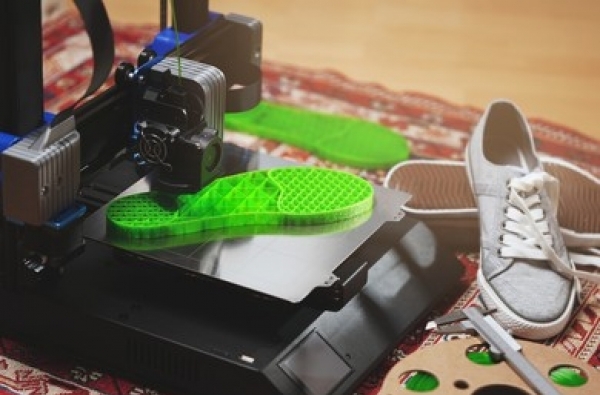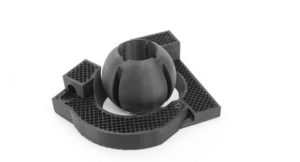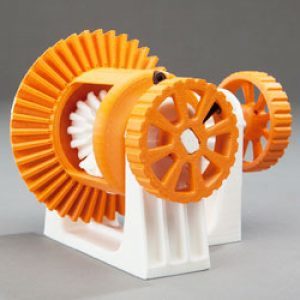
Think of 3D printing, and which technology comes to your mind first?
Fused Deposition Modeling (FDM), isn’t it?
Patented in 1989 by Scott Crump, Fused Deposition Modeling remains the most common and the fastest technology available at an affordable price. Moreover, manufacturing custom parts with FDM is relatively quick.
Traditionally used by companies for their prototypes, manufacturing process, product development, and sampling, FDM technology is widely used in various industries such as automotive, aerospace, healthcare, and consumer goods.
What is FUSED DEPOSITION MODELING (FDM)?

Fused deposition modeling is also popularly known as fused filament fabrication (FFF). This FDM additive manufacturing (AM) process builds an object in a layer-by-layer path using melted thermoplastic polymer.
During the process, polymers are used as 3D Printing filaments. The filaments melt on heating. They are then, extruded by the nozzle of a 3D machine or printer to coat an object in layers. The nozzle moves in both horizontal and vertical directions by computer-aided manufacturing (CAM) software.
CHARACTERISTICS OF FDM 3D PRINTING
When using FDM as the manufacturing process, the designer should understand the characteristics of FDM 3D printing beforehand. Here are some common features that should be kept in mind to get the best results:
- Warping
One of the most common flaws is warping. Dimensions of the extruded material decrease when it cools during solidification. Various parts of the print cool at different rates, and their dimensions also change at varying rates.
Due to the difference in cooling, internal tensions build up, and the bottom layer rises upward, causing warping.
Warping can be avoided by observing and maintaining the temperature of the chamber and the build platform. Proper adhesion between the build platform and the component is also helpful. Moreover, by making the correct choices, you can avert warping, such as:
- Try avoiding large flat areas as they are more prone to warping,
- Add an extra stress-relieving material at the edges of thin features that stay connected with the build platform to avoid warping.
- Try to add fillets to the design when they have sharp corners,
- Check the material’s susceptibility to warping. ABS is more liable to warping compared to PLA or PETG.
- Layer adhesion
Expecting a good adhesion between deposited layers for an FDM component is condemned. When molten thermoplastic is extruded through the nozzle from an FDM machine, the material presses against the preceding, printed layer. Later, due to high temperature and pressure, the layer re-melts and bonds with the preceding layer. The binding strength between various layers is less when compared to the material’s base strength.
When molten material presses against the preceding, printed layers, the shape changes. That is why the parts of FDM have a wavy surface. The height of the layer does not make a difference. Also, post-processing for small features like small threads or holes is needed.
- Support structure
The FDM printers cannot deposit molten thermoplastic in thin air. Due to this, a few geometries require a support structure. Usually, printed in the same material as the parts themselves.
Compared to the remaining part of the item, the surface quality of the surfaces printed on supports is less. Also, it can be difficult to remove it. Due to this, the usage of support structures is minimized. There are support materials available in industrial printers where it can dissolve in liquid. But are generally used jointly with higher-end FDM 3D printers. Moreover, the overall cost of a print increases when dissolvable prints are used.
- Infill and Shell thickness
Usually, FDM printers don’t create solid parts to save on materials and print time. Instead, the outer perimeter, called the shell prints, utilizes multiple passes, whereas the interior, called the infill, fills with an internal, low-density structure.
DIFFERENT FDM 3D PRINTING MATERIALS

The availability of a wide range of FDM materials has an added advantage when using the FDM 3D printing technique (both desktop and industrial). The list of the most common filaments used in FDM includes engineering materials such as TPU, PA, and PETG, commodity thermoplastics such as ABS and PLA, and high-performance thermoplastics such as PEEK and PEI.
- PLA (Polylactic Acid)
PLA is relatively easy and the most common biodegradable thermoplastic material used in desktop FDM printers. Parts produced using PLA have fine detail. Though prepared from naturally renewable sources like wheat, corn, sugarcane, or other high-carbohydrate sources, it works well for surgical, medical, and food packaging applications.
- ABS (Acrylonitrile butadiene styrene)
This thermoplastic polymer is produced by combining styrene and acrylonitrile in the presence of polybutadiene. It is the second most common FDM filament material used.
ABS is more prone to warping, especially when the machine doesn’t have a heated chamber. But it is typically used when high strength, ductility, and thermal stability are required. Its applications include prototypes, surgical models, prototypes, kitchen appliances, and toys.
- PET (Polyethylene terephthalate)
From the family of polyester, PET is a petroleum derivative thermoplastic. Its modified version is PETG (Polyethylene terephthalate Glycol). It is the most widely used FDM material having unique features such as moisture resistance, transparency, and chemical resistance. Used in food storage, liquid containers, prototypes, graphic displays, and textiles.
- TPU (Thermoplastic polyurethane)
This versatile thermoplastic is used in several industrial applications. Being abrasion-resistant and flexible, TPU is used as a bridge between rigid plastic and elastic rubber. The common applications include automobiles, power tools, film and sheet, and sporting goods.
- PEEK (Poly-ether-ketone)
Member of the Poly-aryl-ether-ketone (PAEK) family, this high-performance, semi-crystalline thermoplastic polymer has specific engineering properties. These qualities make it worthy for metal replacement applications, metal implants, and the International Space Station (ISS) for manufacturing out-of-the-earth replacement parts.
- PPSU (Polyphenylsulfonate)
The high performance of this high-temperature sulfone polymer makes it an ideal choice for healthcare, energy storage, smart devices, and aerospace.
Various other filaments are also used, such as
- Carbon-Fiber-Filled Filaments– These tiny fibers offer strength and stiffness properties.
- Wood-Filled Filaments – Helpful in producing aesthetics of real wood along with composites like cork or wood dust.
- High Impact Polystyrene (HIPS) – Used as a support structure for ABS models.
FDM 3D PRINTER OPTIONS
Now that you have realized that FDM is a good fit, you should consider getting a 3d printer. Here are a few FDM 3D printer options for you to choose from:
- ·Ender 3 Series
It is a simple and sought-after option available for beginners.
- Prusa i3 MK3S+
When looking for a high-tech machine and having a large budget, go for the Prusa i3 MK3S. It offers an abundance of creature comforts like automatic bed leveling and self-identification.
- Ultimaker S3
Specifically for professional use, this machine is reliable and versatile. It has a closed chamber and can-do nozzle temperature up to 280°C allowing the use of various materials to be 3D printed. Also, it supports dual extrusion printing.
CONCLUSION
FDM printer produces high-quality parts with exceptional details using durable FDM materials. FDM parts are known for their strength and rigorousness and allow the swift production of prototypes and functional parts cost-effectively. Due to this, the market for FDM applications has evolved at a phenomenal rate.
